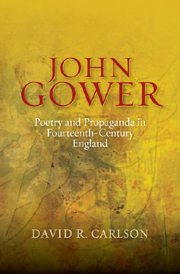Book contents
- Frontmatter
- Contents
- Abbreviations and Citation Forms
- Introduction: Gower in History
- I Fourteenth-Century Panegyric Verse and Official Writing
- II Gower's State-Official Late Poetry
- 6 Official Writing at the Lancastrian Advent
- 7 English Poetry in Late Summer 1399
- 8 The Cronica tripertita and its Official Source
- 9 Gower after the Revolution: Client and Critic
- Bibliography
- Index
- VOLUMES ALREADY PUBLISHED
9 - Gower after the Revolution: Client and Critic
from II - Gower's State-Official Late Poetry
Published online by Cambridge University Press: 05 February 2013
- Frontmatter
- Contents
- Abbreviations and Citation Forms
- Introduction: Gower in History
- I Fourteenth-Century Panegyric Verse and Official Writing
- II Gower's State-Official Late Poetry
- 6 Official Writing at the Lancastrian Advent
- 7 English Poetry in Late Summer 1399
- 8 The Cronica tripertita and its Official Source
- 9 Gower after the Revolution: Client and Critic
- Bibliography
- Index
- VOLUMES ALREADY PUBLISHED
Summary
What most makes the Cronica triperita admirable – the poet's stylistic accomplishment in face of his materials' unpoetic recalcitrance – is also precisely what makes it difficult to admire, even to use. The poem is hard to read, and it was extensively glossed and lengthy. By consequence harder still to enjoy, it did not much circulate; nor can it ever have been conceived as a popular piece of writing, for broad use, even in the much circumscribed contemporary senses of popularity and breadth that would have to be applied at about 1400.
That Henry of Lancaster himself, or such advisors of his as the Justice Thirning, or other more literary participants in the Westminster deliberative bureau of late summer 1399 like Adam Usk, may have believed that some versification of the “Record and Process” would be a good thing to sponsor, for use as propaganda for the new regime, is conceivable, nonetheless, by light of the other evidence for the revolution's historiographic and possible poetic interferences in events at the time. In other circumstances, the Lancastrian's Ricardian and Edwardian predecessor-regimes had interfered earlier, in the fourteenth century, by like literary means.
On the other hand, any state-official instrument of commission put to Gower, if such a commission there were, is unlikely to have specified a thousand Latin lines of disyllabically rhymed Leonine hexameters. Gower's own stylistic development over the years just preceding the revolution, from about 1397 onwards, indicates that he was already beginning to work with the more complex Latin verse-forms on his own, before such events occurred as could have made the Cronica tripertita conceivable.
- Type
- Chapter
- Information
- John Gower, Poetry and Propaganda in Fourteenth-Century England , pp. 197 - 226Publisher: Boydell & BrewerPrint publication year: 2012

